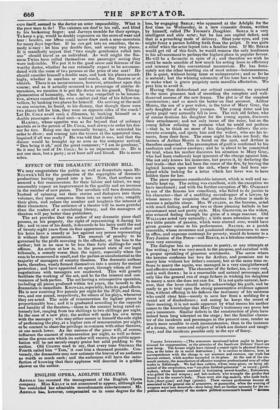VESTED INTERESTS.—[The armourers mentioned below ought to have pe- titioned
for compensation, as the attornies of the Insolvent Debtors' Court are now doing. The former might have claimed a vested right in physical destruc- tion, as the latter do in moral destruction.] It is curious to observe, how, in correspondence with the change in our manners and customs, one trade has become extinct, while another succeeded in its place. At the end of the six- teenth century, the manufacture of offensive weapons predominated overall other trades in Edinburgh. We had then cutlers, whose essay-piece, on being ad- mitted of the corporation, was " ane plain finished quhanzeat " or sword ; gaird- makers, whose business consisted in fashioning sword-handles; Dalmascars, who gilded the said weapon ; and belt-makers, who wrought the girdles that bound it to the wearer's body. There were also dag-makers, who made hack- buts (short guns) and dags (pistols). These various professions became all associated in the general one a armourers, or gunsmiths, when the wearing of weapons went into desuetude—there being then no further necessity for the ex- pedition and expediency of the modern political economist's boasted ,4 &aim of labour." As the above arts gave way, those which tended to provide the comforts and luxuries of civilized life gradually arose. About 1586, we find the first. notice of locksmiths in Edinburgh, and there was then only one of the trade, whose essay was simply "a kist lock." In 1609, however, as the security of property increased, the essay was "a kist lock and a hing, an bois lock, with an double plate lock;" and in 1644, "a key and sprent band" were added to the essay. In 1682, " a cruik and cruik band " were further added; and in 1728, for the safety of the lieges, the locksmith's essay was ap- pointed to be " a cruik and cruik band, a pass lock with a round filled bridge, not cut or broke in the backside, with nobs and jamb bound." In 1595, we find the first notice of shearsmiths. In 1609, a heckle-maker was admitted into the Corporation of Harnmermen. In 1613, a tinkler makes his appearance; Tho- mas Duncan, the first tinkler, was then admitted. Pewtberers are mentioned so far back as 1588. In 1647, we find the first knock-maker [clock-maker],
but so limited was his business that he was also a locksmith. In the first white -ironman was admitted; also the first harness-maker, though lorimers had previously existed. Paul Martin, a distressed French Protestant, in 1691, was the first manufacturer of surgical instruments in Edinburgh. In 1720, we find the first pin-maker. In 1764, the first edge-tool maker, and first fish-hook- maker.— Chambers's .Reekiana.





















 Previous page
Previous page